MARIANI’S
Virtual
Gourmet
JULY
10, 2016
NEWSLETTER

❖❖❖
IN THIS ISSUE
ROME'S HOTELS,
Part Two
By John Mariani
NEW YORK CORNER
BILL'S
By John Mariani
NOTES FROM THE WINE CELLAR
A CRITIQUE OF PURE RIESLING, Part Three
By John A. Curtas
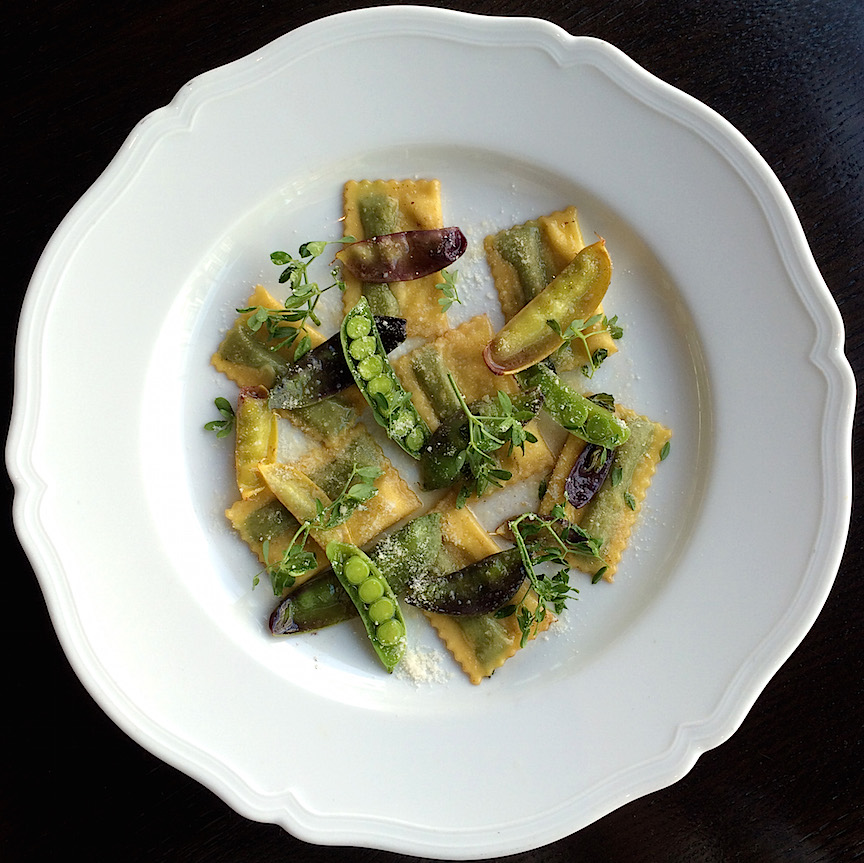 VERY SPECIAL EVENT: On July 7
Lincoln Ristorante at Lincoln Center
in NYC will host a Sugar Snap Pea Dinner, with
special guest, pioneering botanist and inventor of
the snap pea back in 1979, Calvin Lamborn. Chefs
Marco Canora, Wylie Dufresne, and Justin Smillie
will join Lincoln Chefs Jonathan Benno and Richard
Capizzi to cook a five-course dinner highlighting
the selection of peas. It will be a rare evening
offering guests the chance to taste several
varietals of the peas, and meet the extraordinary
man known as the ‘Snap Pea Sensei.’ 5 Course Dinner
$150 pp. (plus tax and gratuity). Lincoln
Ristorante, 142 West 65th Street;
212.359.6500. http://bit.ly/1UdEtmq
VERY SPECIAL EVENT: On July 7
Lincoln Ristorante at Lincoln Center
in NYC will host a Sugar Snap Pea Dinner, with
special guest, pioneering botanist and inventor of
the snap pea back in 1979, Calvin Lamborn. Chefs
Marco Canora, Wylie Dufresne, and Justin Smillie
will join Lincoln Chefs Jonathan Benno and Richard
Capizzi to cook a five-course dinner highlighting
the selection of peas. It will be a rare evening
offering guests the chance to taste several
varietals of the peas, and meet the extraordinary
man known as the ‘Snap Pea Sensei.’ 5 Course Dinner
$150 pp. (plus tax and gratuity). Lincoln
Ristorante, 142 West 65th Street;
212.359.6500. http://bit.ly/1UdEtmq
❖❖❖
ROME'S HOTELS, Part Two
By John Mariani
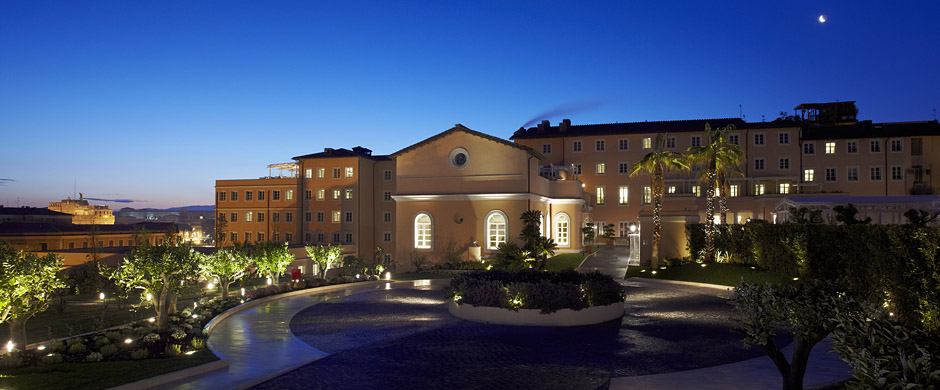
While the allure of Rome
may make tourism its principal industry, it is
also a major international business center whose
travelers require as much modernity and
efficiency as they do the traditional comforts
of a city that can be mindbogglingly difficult
to negotiate.
These travelers also may regard being
slightly out of the way from Rome’s tourist
maelstrom or as near as possible to exit options
as virtues during a short stay. Here
are some diverse hotels that fill those
requirements splendidly.
 GRAN
MELIÁ ROME
GRAN
MELIÁ ROME
The new Gran Meliá
Rome boasts a marvelous panorama on the great
city, preceded by a short ride up a winding hill,
removing you from the traffic miasma below.
Indeed, the sprawling manor seems more like a
country resort than a city hotel with public
spaces wider, broader and longer than most others
in Rome, and a very young staff, fluent in several
languages who try very hard to make your stay
according to what your personal ideals of service
might be. Still,
though you seem remote, you may walk to Trastevere
and the Vatican in five minutes and to the Piazza
Navona in fifteen.
This makes the best of both
possible worlds—very old and very new—the theme
throughout the hotel, with its outdoor pool
surrounded by the city’s first botanical gardens,
themselves worth a leisurely stroll. The
indoor pool more resembles what a wealthy Roman of
50 AD might have kept all to himself. The
naturally lighted spa is by Clarins and includes a
relaxation area,
sauna, Turkish bath with chrome-aromatherapy,
sensorial showers, external vitality pool,
private Turkish bath, and fitness area with a
personal trainer service.
My favorite public room is the Library (left), set in
what was once a 19th century church, where you can
relax, have cocktails or a snack,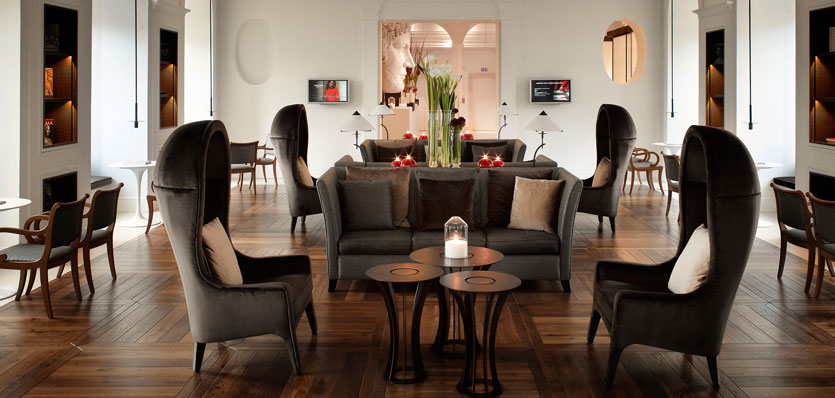 also
available at the casual glassed-in Nectar Bar.
also
available at the casual glassed-in Nectar Bar.
More upscale dining is in
Vivavoce, whose chef consultant is the great
Alfonso Iaccarino of Don Alfonso near Naples.
The premises were once the site
of the Villa Agrippina, home to emperor Nero’s
mother, overlooking the Tiber. We stayed in a
premium double room with a city view (left), the
sleeping area, above whose bed is a stunning
life-size faux mural capturing a section of a
Renaissance painter’s masterpiece, was not
particularly spacious, although the glassed-in
bath and shower were larger and more California in
style than you’d ever expect in Rome.
BAGLIONI HOTEL REGINA
Via Veneto, 70/A
+39 06 421111
regina-hotel-baglioni-rome
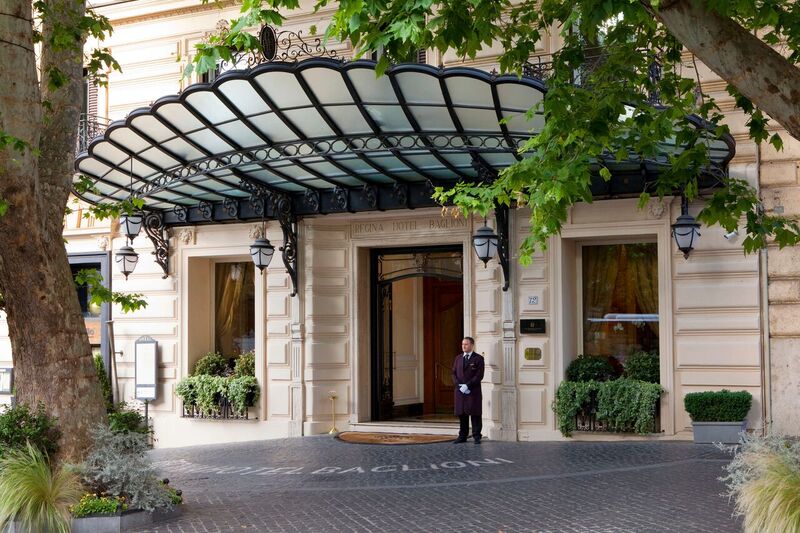
Who doesn't want to stay on
the Via Veneto—the fabled winding street bound by
the Villa Borghese and the Piazza Barbarini? The
Baglioni Hotel Regina, now within the Baglioni
empire, has maintained and refreshed its effusive
art déco exterior, with its fanned out glass and
metal awning, the polished marble lobby and
bright, very comfortable, modern rooms, all
well-wired for the contemporary traveler,
including 60 international TV channels. Our suite
was done in black and off-white colors and buffed
marble floors, heavy patterned draperies, antique
desks and mirrors.
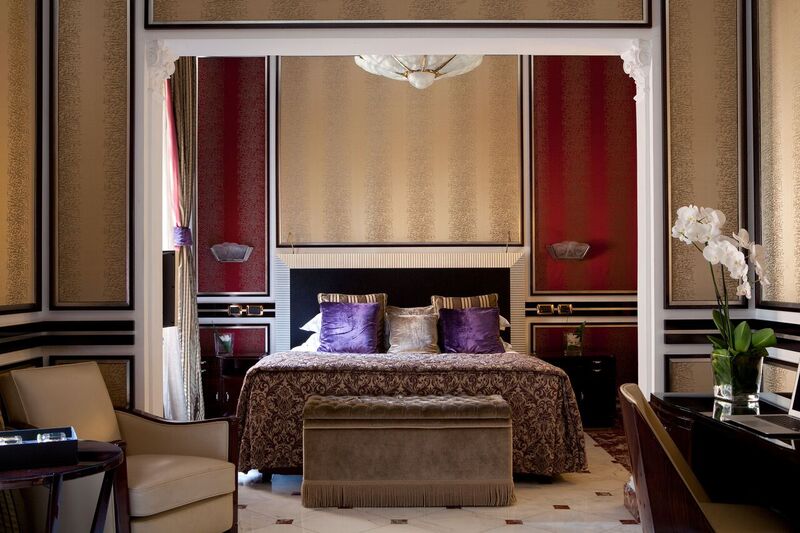 The Regina’s desirable
location within easy walking distance to Maria
della Vittoria church, the Spanish Steps, and Via
Sistina gives it a centrality and access to all
Rome’s transportation, including the subway and
train station.
The Regina’s desirable
location within easy walking distance to Maria
della Vittoria church, the Spanish Steps, and Via
Sistina gives it a centrality and access to all
Rome’s transportation, including the subway and
train station.
The Regina’s Brunello dining
room has the restraint of studied elegance and is
neo-classical in décor, with a glimmering Venetian
chandelier in the lounge area and appointments in the
color purple, which once distinguished the Roman
senatorial class. Our meal was a fine marriage of
Roman, Italian and Mediterranean elements,
including springtime goat’s cheese stuffed
zucchini flowers with just a hint of anchovies;
risotto with salted codfish, yellow 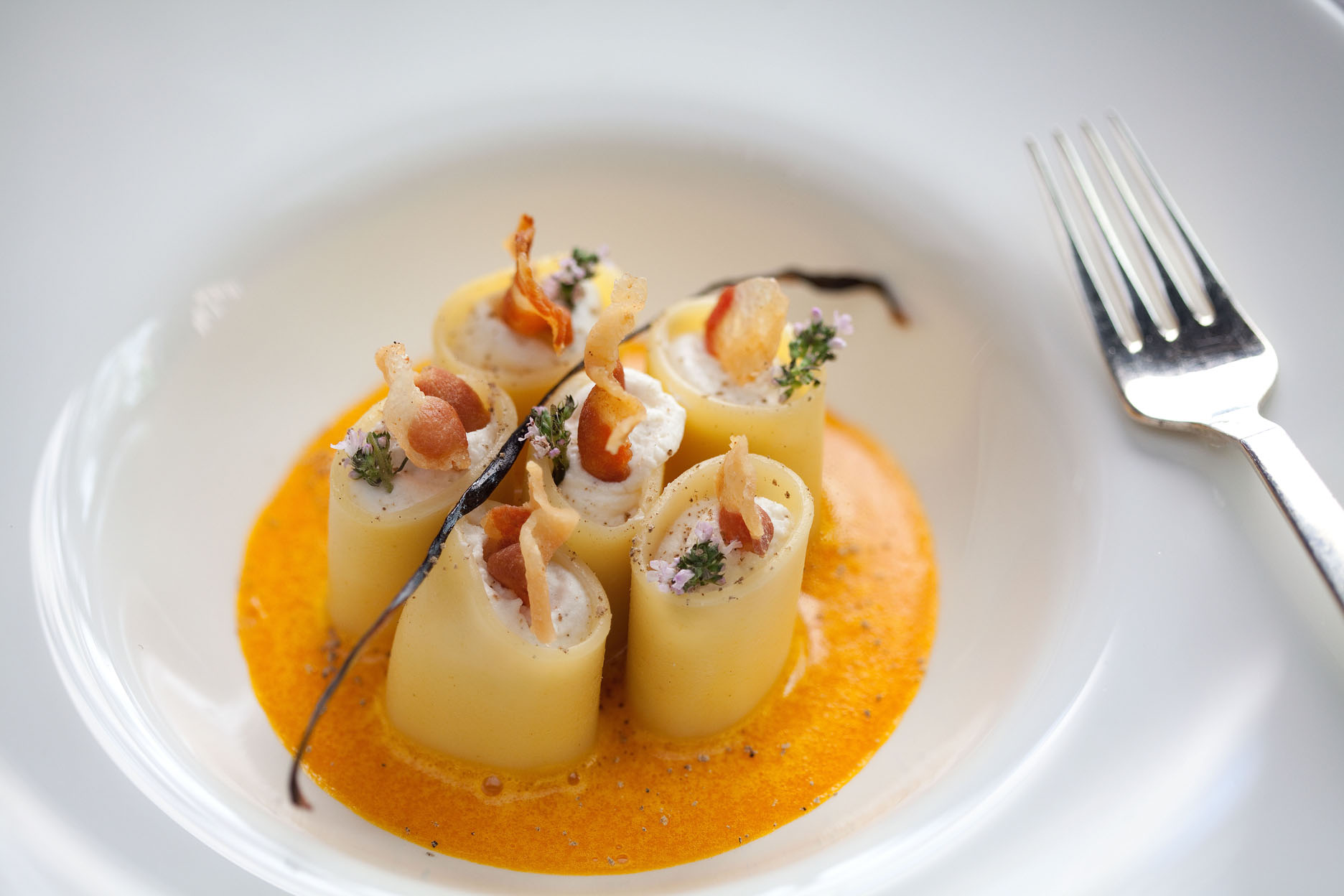 and green
peppers and a dusting of black sesame powder; red
shrimps with a foam of yogurt and granita of
passion fruit; and paccheri pasta
(right)
with basil sauce on cherry tomatoes extract,
buffalo mozzarella flakes and Tuscan olive oil, as
well as several marked vegetarian options.
and green
peppers and a dusting of black sesame powder; red
shrimps with a foam of yogurt and granita of
passion fruit; and paccheri pasta
(right)
with basil sauce on cherry tomatoes extract,
buffalo mozzarella flakes and Tuscan olive oil, as
well as several marked vegetarian options.
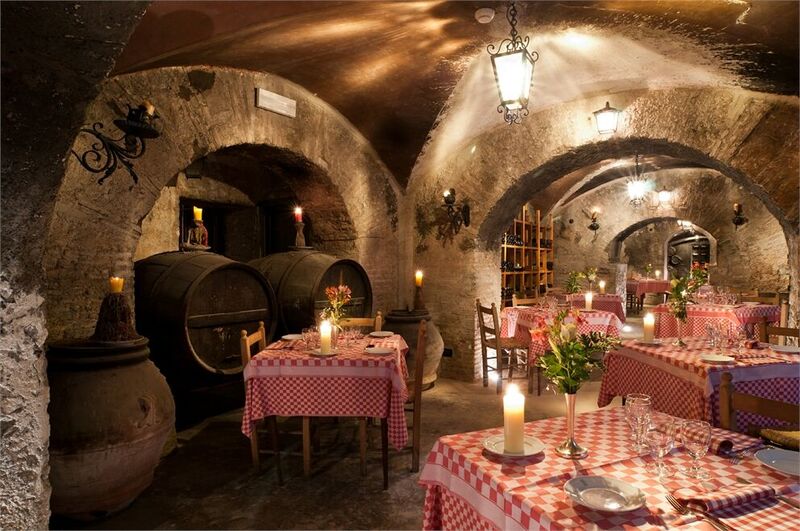 MASSIMO D’AZEGLIO
MASSIMO D’AZEGLIO
Via Cavour, 18
+39- 06 4870270
romehoteldazeglio.it
Just
a block away from the Termini train station, the
Massimo d’Azeglio is easily the most accessible
and luxurious hotel in the neighborhood. It is
owned by the Bettoja family, which also runs the
Mediterraneo across the street, and is done
throughout the public rooms in fin de siècle
décor, 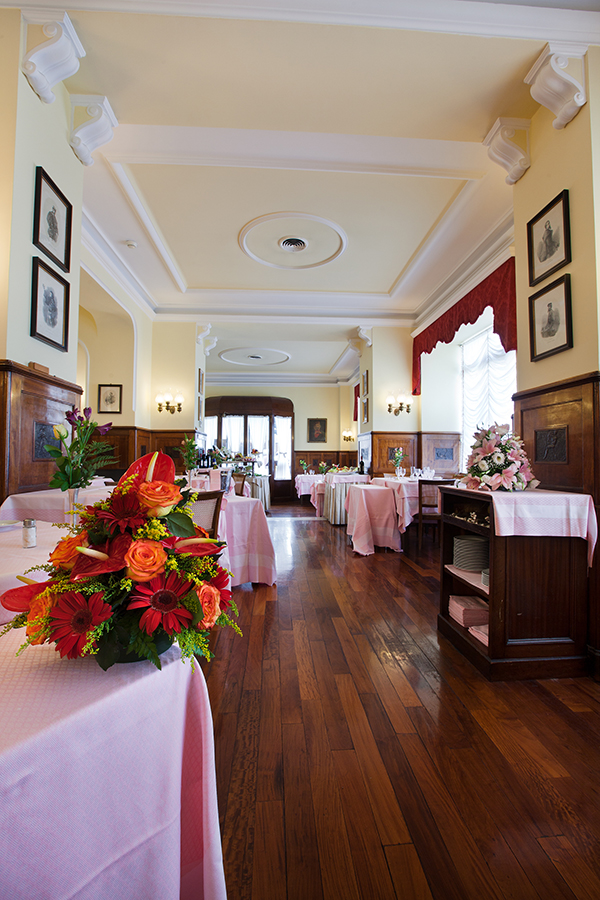 rich in
reds and golds, with a distinguished collection of
paintings from the Risorgimento period of Italy’s
unification, including a self-portrait of
painter-statesman
Massimo d’Azeglio himself.
rich in
reds and golds, with a distinguished collection of
paintings from the Risorgimento period of Italy’s
unification, including a self-portrait of
painter-statesman
Massimo d’Azeglio himself.
With 185 rooms, the hotel is a
particular favorite for business meetings in rooms
outfitted with state-of-the-art tech equipment.
The bedrooms are fairly basic in décor, though
with excellent large bathrooms adding to the
comfort.
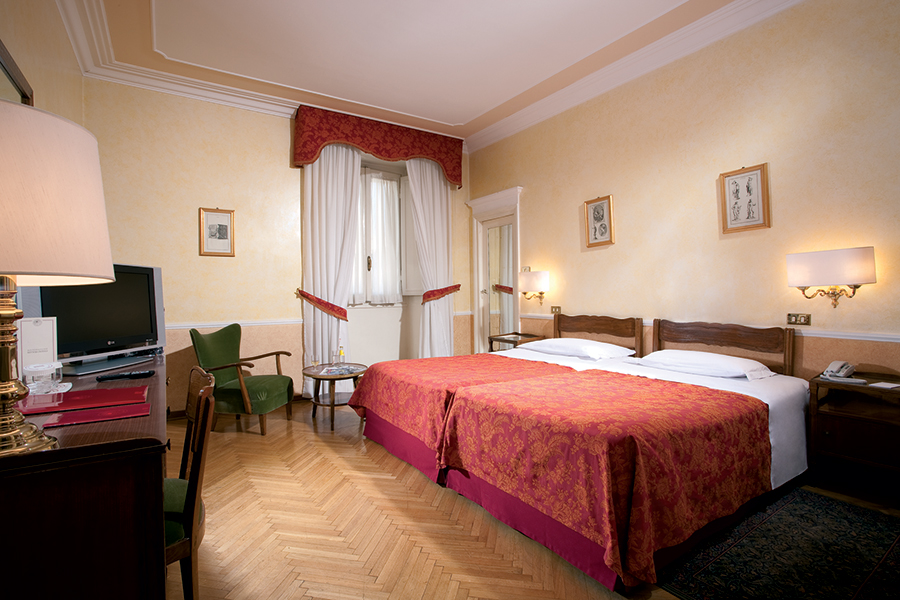 There are two
restaurants, the main dining room (right) at
street level,
and below, a charming, rustic wine cellar
trattoria (above),
at its best when guests are at their most
romantic. We
dined upstairs in a room that has admirably
remained unchanged for decades, except for better
lighting, hearkening back to days when dining was
intended to be relaxing and enjoyed at your
leisure, quiet enough for business, lovely enough
for lingering.
It would not be an idle thought to close
your eyes and imagine Gregory Peck seducing Audrey
Hepburn at a well-set table here with its
flattering pink linens and red flowers, over a
glass of Frascati and dishes from Piedmont, like
codfish with polenta; meat ravioli with scallop
sauce, and a bollito
misto of boiled meats.
There are two
restaurants, the main dining room (right) at
street level,
and below, a charming, rustic wine cellar
trattoria (above),
at its best when guests are at their most
romantic. We
dined upstairs in a room that has admirably
remained unchanged for decades, except for better
lighting, hearkening back to days when dining was
intended to be relaxing and enjoyed at your
leisure, quiet enough for business, lovely enough
for lingering.
It would not be an idle thought to close
your eyes and imagine Gregory Peck seducing Audrey
Hepburn at a well-set table here with its
flattering pink linens and red flowers, over a
glass of Frascati and dishes from Piedmont, like
codfish with polenta; meat ravioli with scallop
sauce, and a bollito
misto of boiled meats.
HOTEL HILTON GARDEN
INN, ROME CLARIDGE
Viale Liegi 62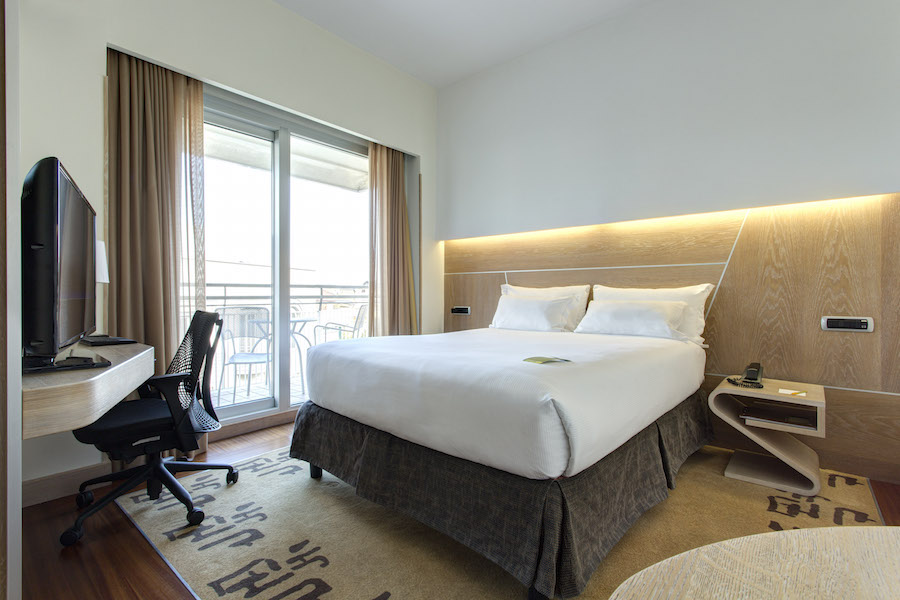
39-06-845441
hilton-garden-inn-rome-claridge
The
modern Hotel Hilton Garden Inn, Rome Claridge
makes no bones about its situation and style as a
place for the business traveler to alight and
perhaps leave within 24 hours. There is a 24-hour,
high-tech business center (below), a
small fitness room, and the uncluttered rooms are
Spartan in their décor.
 We found
the reception and concierge staff particularly
well versed in the needs of a guest who may have
to be in and out in a hurry at any time of the
day.
We found
the reception and concierge staff particularly
well versed in the needs of a guest who may have
to be in and out in a hurry at any time of the
day.
For this reason, perhaps, not
much thought seems to have been put into the
restaurant menu, which is little more than
serviceable for a post-workday dinner, though the
breakfast buffet was more than adequate, and
included in the room rate.
❖❖❖
By John Mariani
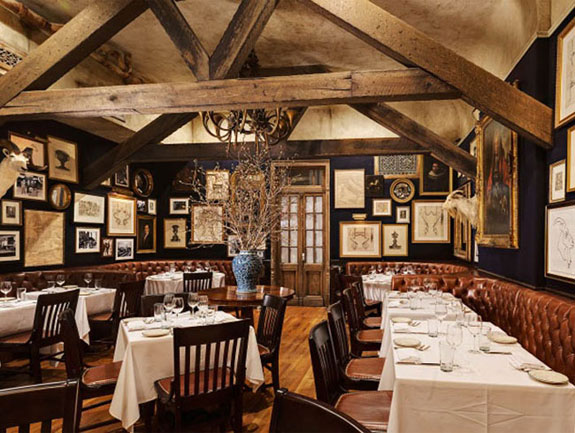 BILL'S
BILL'S
57
East 54th Street (off Madison Avenue)
212-518-2727
bills54.com
The East Side
townhouse that is home to Bill’s dates back to
1924 as a speakeasy, when food was not on most
patrons’ minds.
After Prohibition loosened its mushy grip,
the premises were transformed into Bill’s Gay Nineties,
known as much for its basic food as for its
sing-along piano bar and the silver dollars
imbedded in the bar’s wooden floor (left). So
there’s a lot of history still in the rafters,
along with vintage prints and artwork, book-lined
walls, a fireplace, stuffed animal heads, sports
memorabilia, hunting bugles chandeliers, ship’s
wheels, ceiling fans, leather banquettes, and
tables set with starched linens.
A few years
back Bill’s Gay Nineties closed, an event that
provoked elegies from NYC’s old-time newspaper
wags, so its re-opening in 2013 was eyed
suspiciously, especially since the awkwardly named
Crown Group Hospitality made it plain they sought
to attract the kind of people who wear real and
knock-off Ralph Lauren, arrive in town cars, and
create the deafening din of people whose voices,
as Scott Fitzgerald said, “were full of money.” But
that ploy, along with some nasty company shake-ups
and unpaid lease bills, didn’t last long and,
after a brief flare-up of interest, Bill’s closed
yet again.
Now, since April, what is now
called Bill’s Townhouse seems on much surer
footing, thanks to veteran restaurateur Curt
Huegel, whose previous involvement included Scarpetta
and American Cut, and to a kitchen
now far more dependable under Chef Angel Vela,
previously at Pastis and Waverly Inn, while
Manager Stephanie Gonzalez works hard to make
everyone welcome. 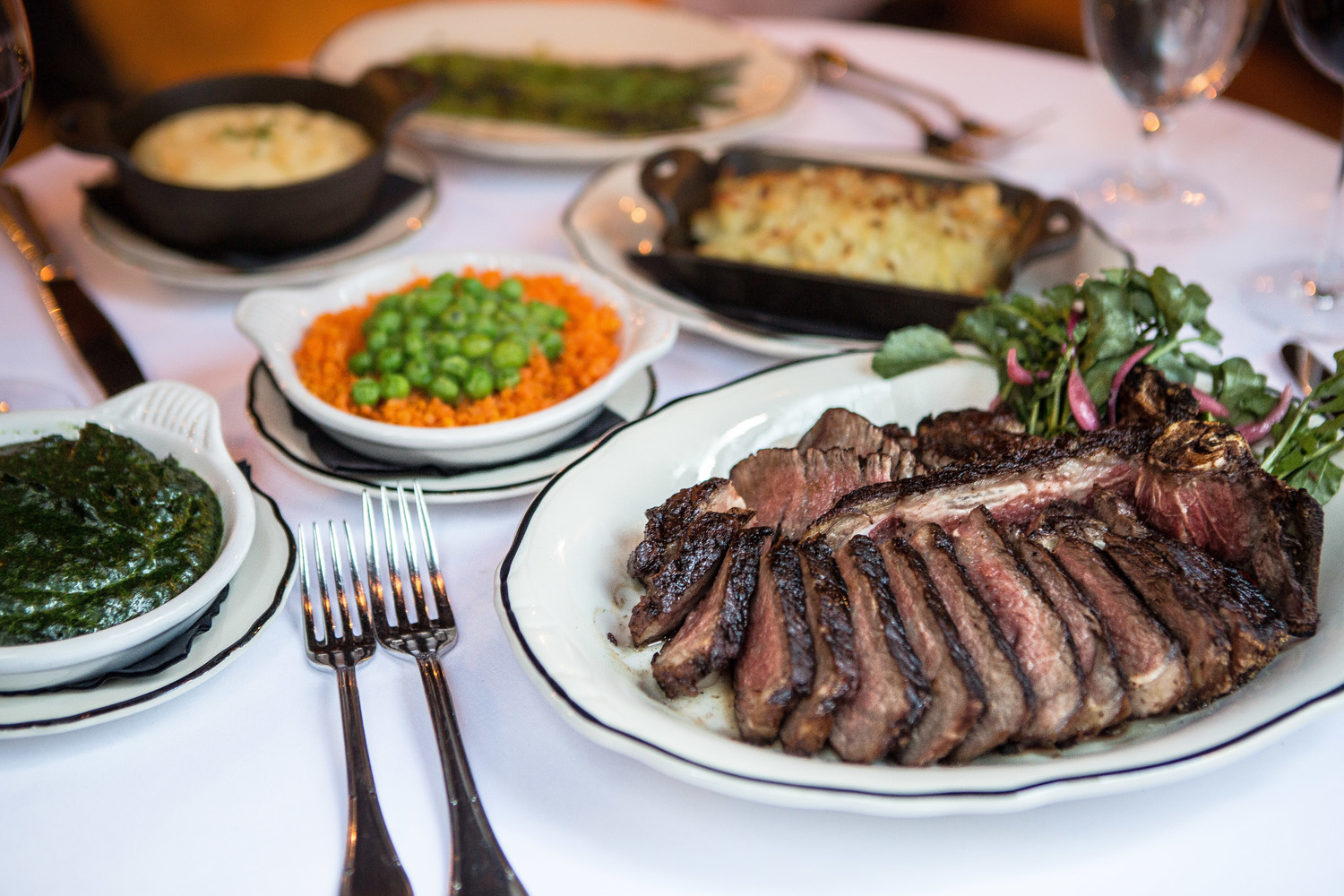
It’s
been
a while since I’ve heard the word “barfly”—a term
that dates back to 1906 in American print—to
describe a regular and committed imbiber at a
saloon, but it seems worth bringing back to
describe the downstairs clientele at Bill’s, where
the bar is mainly filled with loud men just off
from work, their ties askew, bellying up to the
bar for another round of Bud Light or Absolut on
the rocks.
They are a raucous lot, and,
although there are a couple of tables downstairs
and a couple more outside for summer, anyone
wishing to have a good meal and conversation with
friends will find upstairs (right) fare
more appealing.
Bill’s
menu is what it is, though, without sounding
presidential, that depends upon what the meaning
of “is” is.
What it is is unabashedly traditional New
York-American fare of a kind that has never gone
out of style, just as the menus of the classic
bistros of Paris and the tavernas of Mykonos will
resolutely be ever the same. So, of
course, there’s the requisite raw bar selections,
which on the night I visited featured Wellfleet
oysters ($18) and a colossal lump crabmeat
cocktail ($20).
There are about a dozen 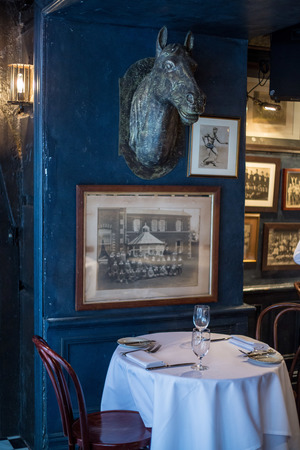 appetizers, along with
one or two nightly specials, including lobster
thermidor ($25), a 19th century Escoffier classic
that went out of style in the modern foodie era. Usually
this dish of lobster meat cooked with cream,
butter, brandy, mustard and tarragon can be too
rich when served as a main course, but at Bill’s
it makes a capital starter, without the lobster
being overwhelmed by the sauce; it’s a dish worth
bringing back from the Gilded Age.
appetizers, along with
one or two nightly specials, including lobster
thermidor ($25), a 19th century Escoffier classic
that went out of style in the modern foodie era. Usually
this dish of lobster meat cooked with cream,
butter, brandy, mustard and tarragon can be too
rich when served as a main course, but at Bill’s
it makes a capital starter, without the lobster
being overwhelmed by the sauce; it’s a dish worth
bringing back from the Gilded Age.
Veal and porcini
meatballs with ricotta and fried sage ($18)
were delicious, if not classic America, but the
crabcake, with cabbage slaw and tartar sauce
($19), lacked the colossal lump crabmeat served in
the raw bar cocktail, instead too firmly packed
with shreds of
crab. “Bill’s
Housemade Buttered Egg Noodles” ($12) were just
that and nothing more, nice, egg-rich noodles with
butter, with
nightly variations, so one order is fine for a
table of four as a side dish.
Among
the entrees, a roasted half chicken ($29) was
excellent, big breasted with very crisp, burnished
gold skin, juicy to the bone and served with
carrots, onion and a dash of lemon. We
tried a veal chop ($52) special, with pesto
sauce that did nothing for the superlative chop
I’d rather have had without it because it was a
very fine piece of meat. Indeed, wherever Bill’s
buys its beef, it must save special cuts for the
restaurant because both the 14-ounce New York
strip ($51) and the bone-in ribeye ($57) were
among the very best I’ve had in a city manic about
its steakhouse fare. Bill’s were nicely charred,
medium-rare as ordered, and had both the richness
of fat-rich marbling and the tangy minerality a
great steak should have. Were I ravenous for just a
slab of beef, but not in the mood for the
caterwauling ambiance of a typical NYC steakhouse,
I’d head straight to the civilized and historic
surroundings of Bill’s and have it there. Oh, and
the “cheesy potatoes” ($10) and trio of sautéed
onions ($10) made good sides for such steaks.
Of the desserts I tried I’ll
go, as ever, for the S&S Cheesecake, almost a
staple of New York chophouses and a standard for
what a dense but moist slice of this cream cheese
confection should be.
The wine list is not
cheap, especially the wines by the glass: a Nino
Franco Rustico Prosecco goes for $14 a glass, the
same price as an entire bottle in a NYC wine shop;
Villa Antinori Chianti Classico Riserva 2011 $17
versus $26; MacRostie Chardonnay 2012 is $17
versus $23. By the bottle, the listings
shoot past $100 quickly, with mark-ups about 300%
above retail, with Pio Cesare Barbaresco an
eye-popping $275, which sells in a store for
about$60-$65.
That
famous and beloved cheesecake, which has been made
in the Bronx for more than half a century, is a
natural choice for a place like Bill’s, which
itself is a repository of NYC gastro-lore. Were
Bill’s only a nostalgia trip, it might be worth a
burger and beer at the bar. But in
its present re-incarnation, Bill’s manages to add
measurably to its cherished image by polishing it
to a shining modernity. Bill’s may not be as raffish
as it once was, but it is still what it is, and
now it’s a whole lot more.
Lunch and
Dinner Mon.-Sat.
❖❖❖
A CRITIQUE OF PURE RIESLING, Part Three
By John A. Curtas
 Friendliness
and approachability are pretty much the watchwords
at Weingut Dr.
Loosen, not to mention elegance, which is
pretty obvious from the moment you step into the
tasting room, just across the river from Weingut
Thanisch. These
stately homes are steeped in history and give you
a feeling of timelessness as you stroll the
cobbled streets of what can only be described as a
Riesling storybook land. Wine shops and tourists
are everywhere, and you half expect Hansel and
Gretel to come strolling out of one of
half-timbered houses.
Friendliness
and approachability are pretty much the watchwords
at Weingut Dr.
Loosen, not to mention elegance, which is
pretty obvious from the moment you step into the
tasting room, just across the river from Weingut
Thanisch. These
stately homes are steeped in history and give you
a feeling of timelessness as you stroll the
cobbled streets of what can only be described as a
Riesling storybook land. Wine shops and tourists
are everywhere, and you half expect Hansel and
Gretel to come strolling out of one of
half-timbered houses.
Looming over it all is the
impossibly steep Berncasteler Doctor, the most
famous vineyard in Germany. The village of
Bernkastel-Kues (really two villages on opposite
sides of the river) has been at the center of the
German wine world since Roman times, and Dr.
Loosen's headquarters are right in the middle of
town. Markus Schulte, our wine guide for the
morning, brought an armful of maps, pictures, and
props to demonstrate what makes the soil and the
exposure so valuable in this region. One of
the most stunning was a famous photo of the Doctor
vineyard, showing a frost on the ground all around
it, but, owing to its position on the river,
providing a clear and warm terroir for the vines
fortunate enough to be drinking up the sun being
reflected from the water.
For all of its
history, though, Dr. Loosen (right) has
made a name for his winery as one of the most
modern of the German wine estates. Since taking
over the family business in 1988, Ernst Loosen has
turned a modest estate (at the time comprising 19
acres of planted vines) into a Middle Mosel
powerhouse, with almost a hundred acres planted.
Loosen makes three blended wines, a non-estate
Riesling called "Dr. L," and two estate Rieslings,
one made from grapes grown entirely on blue slate,
and another from vines in red slate. All three of
these retail for under $15, making them a flat-out
steal for everyday sipping.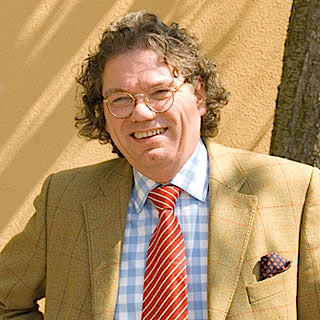
But the core of the Loosen
portfolio are the six old-vine sites from which
Loosen makes both dry and sweet wines that are
benchmark examples of the form. The bouquet,
density and higher alcohol content of these wines
distinguish them from the usual fruity, Mosel
style. These sites represent some of the Mosel's
most coveted: Wehlener Sonnenuhr, Ürziger
Würzgarten, Erdener Prälat, Erdener Treppchen,
Bernkasteler Lay, and Graacher Himmelreich. Each
vineyard is the German equivalent of Grand Cru
vineyards, or Erste
Lage (first class site), which is
designated on the label as "GG," an abbreviation
that stands for Grosses Gewächs wines. Luckily, as we've
noted previously, the taste of the wines more than
makes up for the constant confusion printed on
German labels.
With
the exception of the Dr. L wine, all the wines are
fermented with indigenous yeasts, and aged on
their lees in massive old oak barrels for at least
9 months before being racked. The single vineyard
wines are aged in old oak for between 12 (for
sweet) and up to 24 months (for dry) on the lees
before filtration and bottling.
 As quaffable as Loosen's
entry-level wines are, it's the single vineyard
selections where things get really serious. His
2012 Ürziger Würtzgarten Spätlese may clock in at
only 8.5% alcohol, but it delivers a strong floral
nose and loads of citrus notes all wrapped around
juicy acidity that begs for a second sip. Quite a
mouthful for around $27. Even more stunning was the
2011 Erdener Pralat Alte Reben Auslese Reserve,
not only for the price (around $200), but for the
huge, round, sexy-silky mouth feel of a sweet
grapefruit, offset by concentrated acidity that
advertises its aging potential. It is the stuff
Riesling dreams are made of, and in ten years
could go toe-to-toe with anything the Loire Valley
or Burgundy could throw at you. The reserve we
tasted is probably next to impossible to find in
the United States, but the regular Alte Reben GG
is available in better wine stores for around $60,
and it's nothing to sneeze at either.
As quaffable as Loosen's
entry-level wines are, it's the single vineyard
selections where things get really serious. His
2012 Ürziger Würtzgarten Spätlese may clock in at
only 8.5% alcohol, but it delivers a strong floral
nose and loads of citrus notes all wrapped around
juicy acidity that begs for a second sip. Quite a
mouthful for around $27. Even more stunning was the
2011 Erdener Pralat Alte Reben Auslese Reserve,
not only for the price (around $200), but for the
huge, round, sexy-silky mouth feel of a sweet
grapefruit, offset by concentrated acidity that
advertises its aging potential. It is the stuff
Riesling dreams are made of, and in ten years
could go toe-to-toe with anything the Loire Valley
or Burgundy could throw at you. The reserve we
tasted is probably next to impossible to find in
the United States, but the regular Alte Reben GG
is available in better wine stores for around $60,
and it's nothing to sneeze at either.
To complicate things further,
Loosen has designated some of his dry wines "GGR,"
standing for Grosse
Gewachs Ruhe Reife, or, a dry wine from
the Grosses Gewachs vineyard that has been allowed
to rest (ruhe)
and mature (reife).
Rather than try to keep up with all of this, just
know that regardless of your wine knowledge,
budget, or level of bewilderment, Dr. Ernst Loosen
has a product that will fill the bill and please
your palate.
I came
away
from Mosel actually feeling sorry for German
winemakers. They try to impart as much information
as they can to the consumer (as required by law)
and sincerely want you to know as much about the
bottle as possible before you buy it. But the
densities of the German language defeat them—and
us—every time. Be that as it may, there's
something fascinating about all this ironic
inscrutability,
telling you everything while leaving you in
the dark, that will keep you coming back for more,
once you dive into the deep end of the Riesling
pool and discover the most remarkable and
versatile white wine you will ever taste.
Dr. Loosen
has small tasting rooms within the beautiful
house that holds its business offices. Dr.
Loosen must be contacted in advance for a tour
of the cellars and a tasting of the full panoply
of its wines.
❖❖❖
 BLOCK THOSE METAPHORS!
BLOCK THOSE METAPHORS!“To understand the point of keeping rafter-rattling war horses in the repertoire, all I had to do was eat Benoit’s quenelles de brochet. These two little footballs of happiness are improbably smooth, almost but not quite fluffy, filled with the freshwater richness of pike. . . . I tasted it, and the whole chorus marched out on the stage at once, the orchestra pounding and the fat lady throwing her head back and letting it rip. A standing ovation would have followed if Benoit’s quenelles hadn’t made me feel a bit like the fat lady myself.”—Pete Wells, “Benoit in Midtown Is the Bistro That Will Take You to Paris,” NY Times (2/2/16).
THERE'S NEVER A COP AROUND
WHEN YOU REALLY NEED ONE
A woman in
Hartford, CT, called 911 to complain that the local
Empire Pizza had mistakenly delivered a half-cheese,
half-hamburger pie instead of a half-cheese, half-bacon
one, asking,
Any of John Mariani's books below may be ordered from amazon.com.
 The
Hound in Heaven (21st Century Lion Books)
is a novella, and for anyone who loves dogs,
Christmas, romance, inspiration, even the supernatural, I
hope you'll find this to be a treasured favorite.
The story concerns how, after a New England teacher,
his wife and their two daughters adopt a stray puppy found
in their barn in northern Maine, their lives seem full of
promise. But when tragedy strikes, their wonderful dog
Lazarus and the spirit of Christmas are the only things
that may bring his master back from the edge of
despair.
The
Hound in Heaven (21st Century Lion Books)
is a novella, and for anyone who loves dogs,
Christmas, romance, inspiration, even the supernatural, I
hope you'll find this to be a treasured favorite.
The story concerns how, after a New England teacher,
his wife and their two daughters adopt a stray puppy found
in their barn in northern Maine, their lives seem full of
promise. But when tragedy strikes, their wonderful dog
Lazarus and the spirit of Christmas are the only things
that may bring his master back from the edge of
despair. WATCH THE VIDEO!
“What a huge surprise turn this story took! I was completely stunned! I truly enjoyed this book and its message.” – Actress Ali MacGraw
“He had me at Page One. The amount of heart, human insight, soul searching, and deft literary strength that John Mariani pours into this airtight novella is vertigo-inducing. Perhaps ‘wow’ would be the best comment.” – James Dalessandro, author of Bohemian Heart and 1906.
“John Mariani’s Hound in Heaven starts with a well-painted portrayal of an American family, along with the requisite dog. A surprise event flips the action of the novel and captures us for a voyage leading to a hopeful and heart-warming message. A page turning, one sitting read, it’s the perfect antidote for the winter and promotion of holiday celebration.” – Ann Pearlman, author of The Christmas Cookie Club and A Gift for my Sister.
“John Mariani’s concise, achingly beautiful novella pulls a literary rabbit out of a hat – a mash-up of the cosmic and the intimate, the tragic and the heart-warming – a Christmas tale for all ages, and all faiths. Read it to your children, read it to yourself… but read it. Early and often. Highly recommended.” – Jay Bonansinga, New York Times bestselling author of Pinkerton’s War, The Sinking of The Eastland, and The Walking Dead: The Road To Woodbury.
“Amazing things happen when you open your heart to an animal. The Hound in Heaven delivers a powerful story of healing that is forged in the spiritual relationship between a man and his best friend. The book brings a message of hope that can enrich our images of family, love, and loss.” – Dr. Barbara Royal, author of The Royal Treatment.
 |
The Encyclopedia of American Food and Drink by John F. Mariani (Bloomsbury USA, $35) Modesty forbids me to praise my own new book, but let me proudly say that it is an extensive revision of the 4th edition that appeared more than a decade ago, before locavores, molecular cuisine, modernist cuisine, the Food Network and so much more, now included. Word origins have been completely updated, as have per capita consumption and production stats. Most important, for the first time since publication in the 1980s, the book includes more than 100 biographies of Americans who have changed the way we cook, eat and drink -- from Fannie Farmer and Julia Child to Robert Mondavi and Thomas Keller. "This book is amazing! It has entries for everything from `abalone' to `zwieback,' plus more than 500 recipes for classic American dishes and drinks."--Devra First, The Boston Globe. "Much needed in any kitchen library."--Bon Appetit. |
"Eating Italian will never be the same after reading John Mariani's entertaining and savory gastronomical history of the cuisine of Italy and how it won over appetites worldwide. . . . This book is such a tasteful narrative that it will literally make you hungry for Italian food and arouse your appetite for gastronomical history."--Don Oldenburg, USA Today. "Italian
restaurants--some good, some glitzy--far
outnumber their French rivals. Many of
these establishments are zestfully described
in How Italian Food Conquered the World, an
entertaining and fact-filled chronicle by
food-and-wine correspondent John F.
Mariani."--Aram Bakshian Jr., Wall Street
Journal.
"Equal parts
history, sociology, gastronomy, and just
plain fun, How Italian Food Conquered the
World tells the captivating and delicious
story of the (let's face it) everybody's
favorite cuisine with clarity, verve and
more than one surprise."--Colman Andrews,
editorial director of The Daily
Meal.com. "A fantastic and fascinating
read, covering everything from the influence
of Venice's spice trade to the impact of
Italian immigrants in America and the
evolution of alta cucina. This book will
serve as a terrific resource to anyone
interested in the real story of Italian
food."--Mary Ann Esposito, host of PBS-TV's
Ciao
Italia. "John Mariani has written the
definitive history of how Italians won their
way into our hearts, minds, and
stomachs. It's a story of pleasure over
pomp and taste over technique."--Danny Meyer,
owner of NYC restaurants Union Square
Cafe, The Modern, and Maialino.
|
 |
 |
 |
 |
 |
 |
 |
 |
 Everett Potter's Travel Report:
Everett Potter's Travel Report: 
 Eating Las Vegas
JOHN CURTAS has been covering the Las Vegas
food and restaurant scene since 1995. He is
the co-author of EATING LAS VEGAS – The 50
Essential Restaurants (the fourth
edition of which will be published in early
2016), as well as the author of the Eating Las
Vegas web site: www.eatinglasvegas.
He can also be seen every Friday morning as
the “resident foodie” for Wake Up With the
Wagners on KSNV TV (NBC) Channel 3 in
Las Vegas.
Eating Las Vegas
JOHN CURTAS has been covering the Las Vegas
food and restaurant scene since 1995. He is
the co-author of EATING LAS VEGAS – The 50
Essential Restaurants (the fourth
edition of which will be published in early
2016), as well as the author of the Eating Las
Vegas web site: www.eatinglasvegas.
He can also be seen every Friday morning as
the “resident foodie” for Wake Up With the
Wagners on KSNV TV (NBC) Channel 3 in
Las Vegas.

MARIANI'S VIRTUAL GOURMET
NEWSLETTER is published weekly. Editor/Publisher: John
Mariani.
Editor: Walter Bagley. Contributing Writers: Christopher Mariani,
Robert Mariani, Misha
Mariani,
John A. Curtas, Edward Brivio, Mort Hochstein,
Andrew Chalk, Dotty Griffith and Brian Freedman. Contributing
Photographers: Galina Dargery, Bobby
Pirillo. Technical Advisor: Gerry McLoughlin.
To un-subscribe from this newsletter,click here.
© copyright John Mariani 2016

